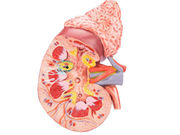Compared to 1995 to 1999, increase in racial/ethnic disparities in receipt of LDKT in 2010 to 2014
THURSDAY, Jan. 4, 2018 (HealthDay News) — Racial/ethnic disparities in the receipt of live donor kidney transplantation (LDKT) among first-time kidney transplantation candidates in the United States increased from 1995-1999 to 2010-2014, according to a study published in the Jan. 2 issue of the Journal of the American Medical Association.
Tanjala S. Purnell, Ph.D., M.P.H., from the Johns Hopkins School of Medicine in Baltimore, and colleagues conducted a secondary analysis of a prospectively maintained cohort study conducted among 453,162 adult first-time kidney transplantation candidates in the United States.
The researchers found that 13.1 percent of adult kidney transplantation candidates received LDKT. The cumulative incidence of LDKT at two years after appearing on the waiting list was 7, 3.4, 6.8, and 5.1 percent among white, black, Hispanic, and Asian patients, respectively, in 1995. The cumulative incidence of LDKT in 2014 was 11.4, 2.9, 5.9, and 5.6 percent, respectively. There was an increase in racial/ethnic disparities in the receipt of LDKT from 1995-1999 to 2010-2014 (P < 0.001 in adjusted models comparing white with black, Hispanic, and Asian patients). In 1995 to 1999, the adjusted subhazard ratio was 0.45, 0.83, and 0.56 among black, Hispanic, and Asian patients, respectively, compared with LDKT receipt among white patients. In 2010 to 2014, the corresponding adjusted subhazard ratios were 0.27, 0.52, and 0.42.
“These findings suggest that national strategies for addressing disparities in receipt of live donor kidney transplantation should be revisited,” the authors write.
Abstract/Full Text (subscription or payment may be required)
Editorial (subscription or payment may be required)
Copyright © 2018 HealthDay. All rights reserved.








